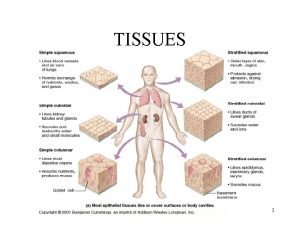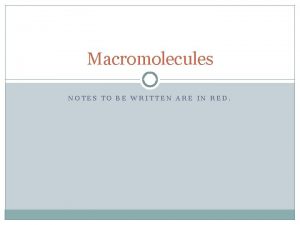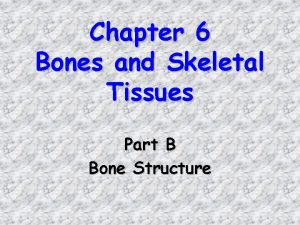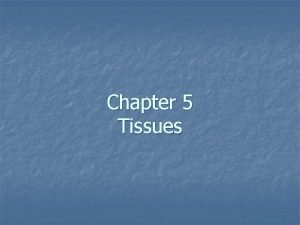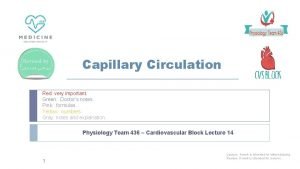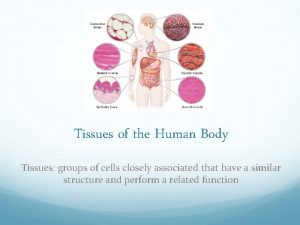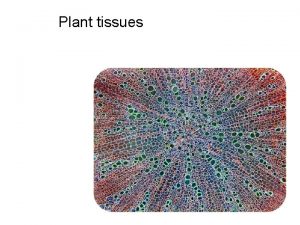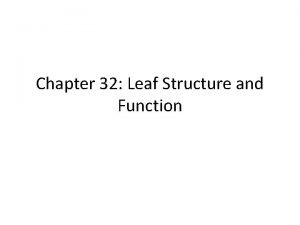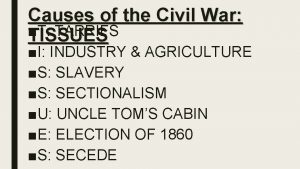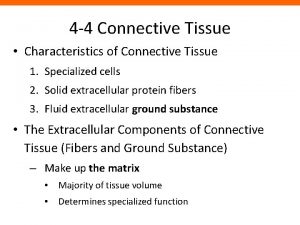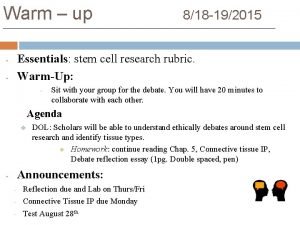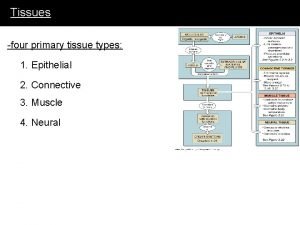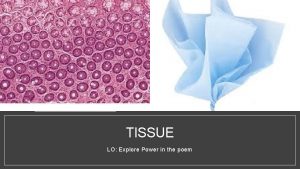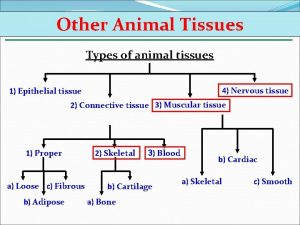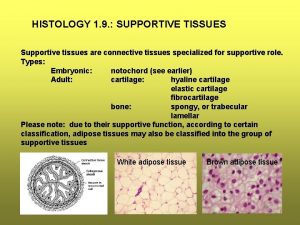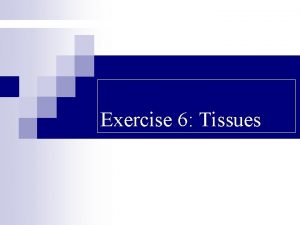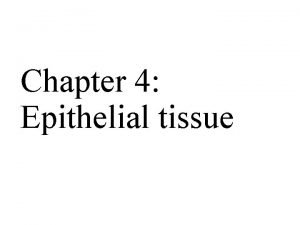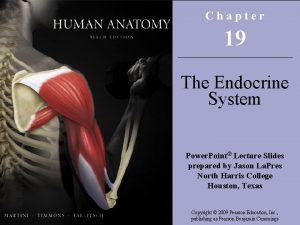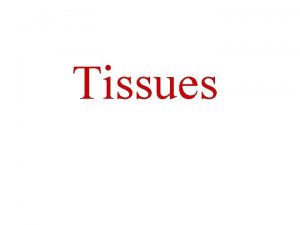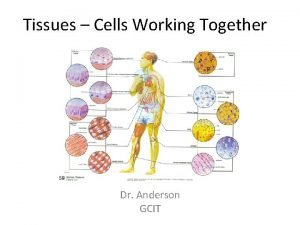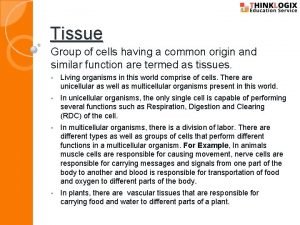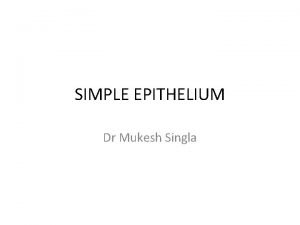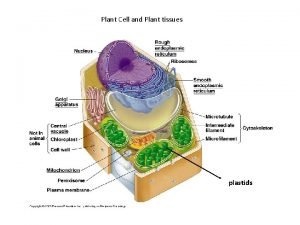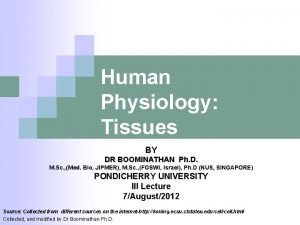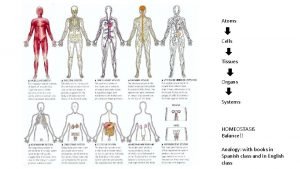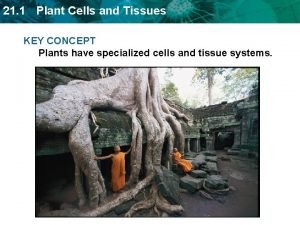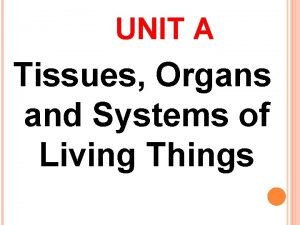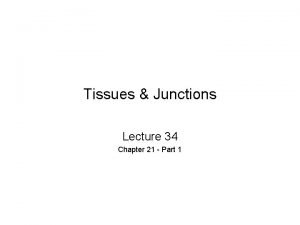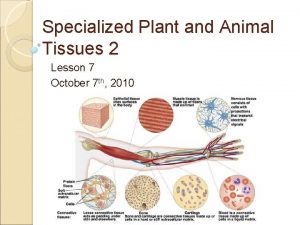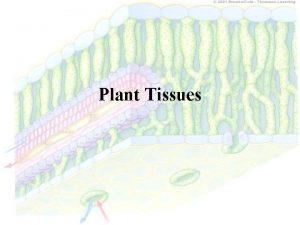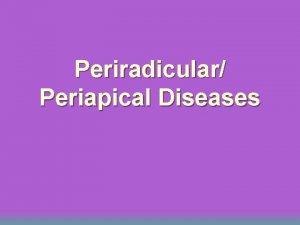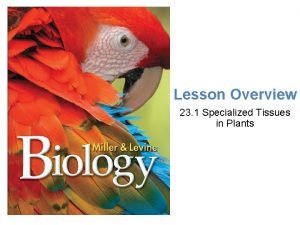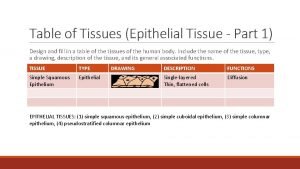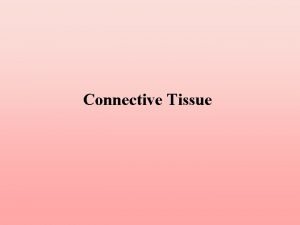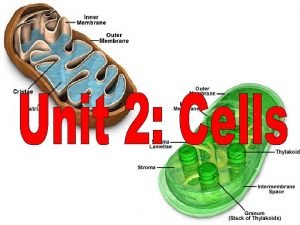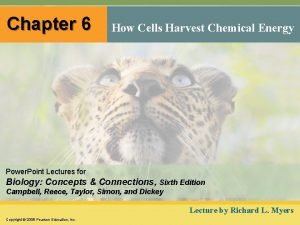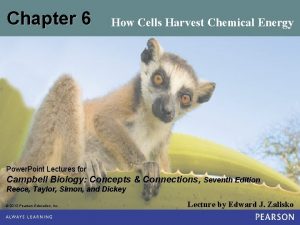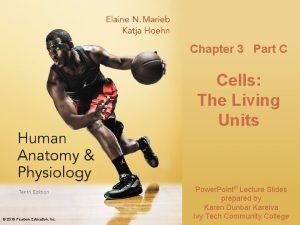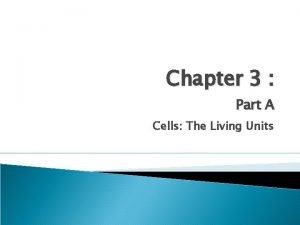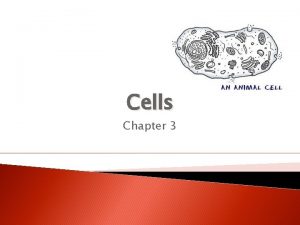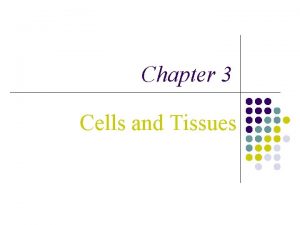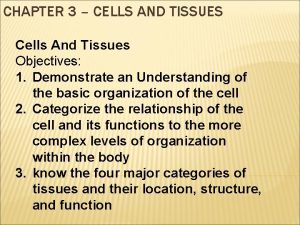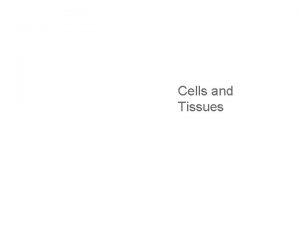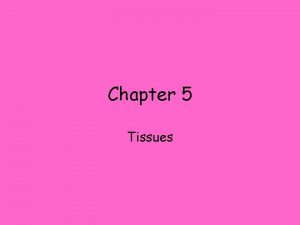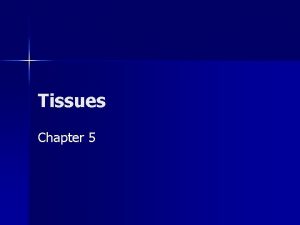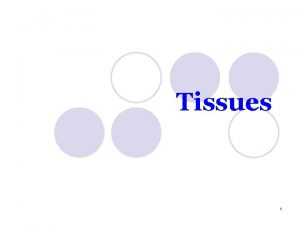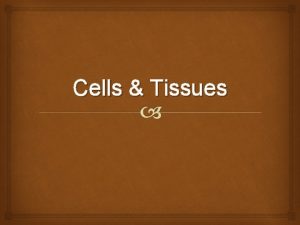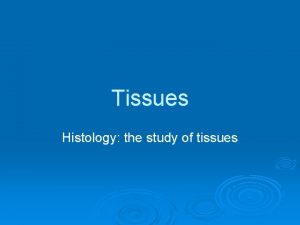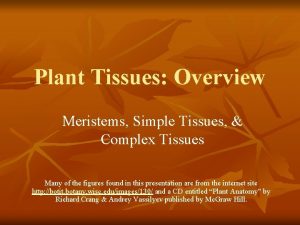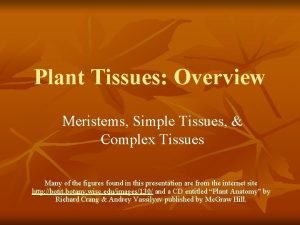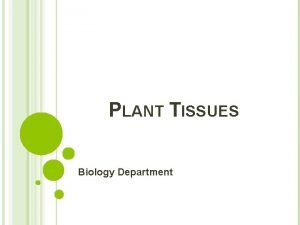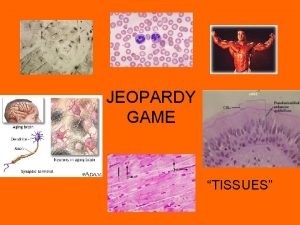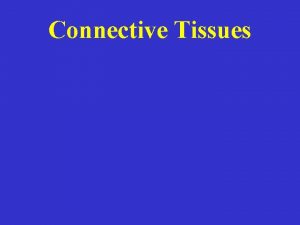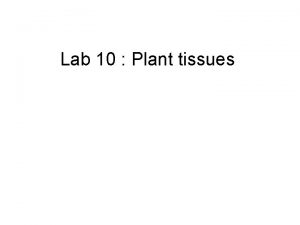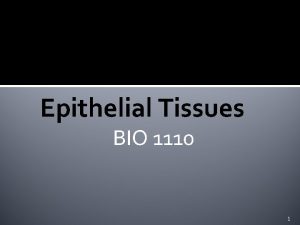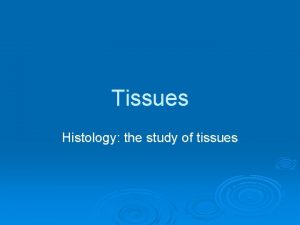Cells and Tissues Part 1 Cells Chapter 3
























































































- Slides: 88

Cells and Tissues Part 1: Cells Chapter 3 1

Outline • • The Cell Theory Cellular Organization (The Parts of a Cell) – Plasma Membrane v – Cytoplasm v v – • • Transport across the plasma membrane Cytosol Organelles Nucleus Protein Synthesis Cell Division – Mitosis 2

The Cell Theory • • Let’s face it, life is totally cellular (this does not refer to the mobile phone) The cell theory states: 1. Cells are the basic unit of life 2. All living things are made up of cells 3. New cells arise only from preexisting cells 3

Table 3. 1 Parts of the Cell: Structure and Function (1 of 5). © 2015 Pearson Education, Inc.

Table 3. 1 Parts of the Cell: Structure and Function (2 of 5). © 2015 Pearson Education, Inc.

Table 3. 1 Parts of the Cell: Structure and Function (3 of 5). © 2015 Pearson Education, Inc.

Table 3. 1 Parts of the Cell: Structure and Function (4 of 5). © 2015 Pearson Education, Inc.

Table 3. 1 Parts of the Cell: Structure and Function (5 of 5). © 2015 Pearson Education, Inc.

Cellular Organization • Plasma membrane surrounds the cell and regulates entrance and exit of substances – – – • Selective barrier Key role in communication between cells Key role in communication of cells with the external environment Cytoplasm is the portion of the cell between the nucleus and plasma membrane – Cytosol: fluid portion of cytoplasm v – • Consistency: semifluid gel, like wet Jello Organelles: small membranous structures each with a specific function The Nucleus- storage of genetic information 9

Cellular Organization (Cont. ) – Nucleus is the centrally located organelle containing chromosomes and is the control center of the cell 10

Figure 3. 4 Structure of the generalized cell. Smooth endoplasmic reticulum Chromatin Nucleolus Nuclear envelope Nucleus Plasma membrane Cytosol Lysosome Mitochondrion Rough endoplasmic reticulum Centrioles Ribosomes Golgi apparatus Microtubule Intermediate filaments © 2015 Pearson Education, Inc. Peroxisome Secretion being released from cell by exocytosis

Plasma Membrane • Plasma membrane is a phospholipid bilayer with attached or embedded proteins – Fluid mosaic model v v Sea of fluid lipids with mosaic of different proteins Phospholipids: polar head and non-polar tails Ø v v v Form spherical bilayer when placed in water Cholesterol Glycolipids Membrane Fluidity: critical for interactions of membrane proteins and allows cellular process e. g. movement, growth, division, secretion Ø Dependent on § Number of double bonds in the fatty acid tails of the lipids § Amount of cholesterol 12

Figure 3. 2 Structure of the plasma membrane. Hydrophilic: Love water Extracellular fluid (watery environment) Glycoprotein Glycolipid Cholesterol Sugar group Polar heads of phospholipid molecules Bimolecular lipid layer containing proteins Nonpolar tails of phospholipid molecules Hydrophobic: Hate water © 2015 Pearson Education, Inc. Channel Proteins Filaments of cytoskeleton Cytoplasm (watery environment)

Plasma Membrane (Cont. ) • • Plasma membrane is selectively permeable, and regulates movement of molecules and ions across the cell membrane due to nature of the phospholipids Plasma membrane proteins form receptors, conductors, or enzymes in metabolic reactions 14

Plasma Membrane (Cont. ) 15

Figure 3. 2 Structure of the plasma membrane. Extracellular fluid (watery environment) Glycoprotein Glycolipid Cholesterol Sugar group Polar heads of phospholipid molecules Bimolecular lipid layer containing proteins Nonpolar tails of phospholipid molecules © 2015 Pearson Education, Inc. Channel Proteins Filaments of cytoskeleton Cytoplasm (watery environment)

The Plasma Membrane Examples of different membrane proteins include § Ion channels § Carriers § Receptors Copyright © John Wiley & Sons, Inc. All rights reserved.

The Plasma Membrane Examples of different membrane proteins include § Enzymes § Linkers § Cell identity markers Copyright © John Wiley & Sons, Inc. All rights reserved.

Plasma Membrane (Cont. ) • Transport across the plasma membrane- Two Types 2. Passive Processes- don’t require ATP Active Processes- require ATP – Passive processes 1. v v Simple diffusion: movement of molecule down concentration gradient Facilitated diffusion Channel-mediated Ø Carrier-mediated Osmosis: diffusion of water down it’s concentration gradient Ø Water moves through bilayer Ø Water moves through aquaporins Concept of Tonicity Ø Must have balance of solutes and water due to selective permeability of membrane to solutes Ø v v 19

Plasma Membrane (Cont. ) • Transport across the plasma membrane (Cont. ) – Passive Processes (Cont. ) v Simple Diffusion is the random movement of molecules from an area of higher concentration to an area of lower concentration until they are equally distributed 20

Figure 3. 9 Diffusion. © 2015 Pearson Education, Inc.

Plasma Membrane (Cont. ) • Transport across the plasma membrane (Cont. ) – Passive Processes (Cont. ) v Facilitated diffusion v Channel-mediated Ø Carrier-mediated Osmosis: diffusion of water down it’s concentration gradient Ø Water moves through bilayer Ø Water moves through aquaporins Ø 22

Figure 3. 10 Diffusion through the plasma membrane. Extracellular fluid Lipidsoluble solutes Lipidinsoluble solutes Small lipidinsoluble solutes Water molecules Lipid bilayer Cytoplasm (a) Simple diffusion of fat-soluble molecules directly through the phospholipid bilayer © 2015 Pearson Education, Inc. (b) Carrier-mediated (c) facilitated diffusion via protein carrier specific for one chemical; binding of substrate causes shape change in transport protein Channel(d) Osmosis, diffusion mediated of water through a facilitated specific channel diffusion protein (aquaporin) through a or through the lipid channel protein; bilayer mostly ions, selected on basis of size and charge

Plasma Membrane (Cont. ) • Transport across the plasma membrane (Cont. ) – Passive Processes (Cont. ) v Osmosis: diffusion of water down it’s concentration gradient Ø Water moves through bilayer Ø Water moves through aquaporins Ø Osmosis is the random movement of water from an area of higher concentration of water to an area of lower concentration of water Ø Important due to the selective permeability of membrane to solutes Ø Leads to the concept of tonicity Ø Tonicity: the ability of a solution to change the water content of a cell due to selective permeability of the membrane and solutes in the solution 24

Principle of Osmosis Left arm Applied pressure = osmotic pressure Right arm Volumes equal Water molecule Osmosis Selectively Solute permeable molecule membrane (a) Starting conditions Osmosis Movement due to hydrostatic pressure (b) Equilibrium (c) Restoring starting conditions

Isotonic solution Hypertonic solution (a) Illustrations showing direction of water movement SEM Normal RBC shape RBC undergoes hemolysis RBC undergoes crenation (b) Scanning electron micrographs (all 15, 000 x)

Plasma Membrane (Cont. ) • Transport across the plasma membrane (Cont. ) – Active processes: need to utilize ATP to drive molecular movement against concentration gradient v v Active Transport: Carrier-mediated transport of molecules by proteins in plasma membrane Vesicular Transport: transport in vesicles, moving substances into or out of the cell Ø Exocytosis: vesicular transport out of the cell Ø Endocytosis: vesicular transport into the cell § Phagocytosis- uptake of bacteria or dead cells § Receptor-mediated- specific binding to cell surface protein before uptake § Pinocytosis- uptake of fluid (cell drinking) 27

Figure 3. 11 Operation of the sodium-potassium pump, a solute pump. Extracellular fluid Na+ Na+-K+ pump K+ Na+ Na+ K+ P ATP Na+ 1 2 3 K+ ADP 1 Binding of cytoplasmic Na+ 2 The shape change expels Na+ to the pump protein stimulates to the outside. Extracellular + phosphorylation by ATP, which K binds, causing release of the causes the pump protein to phosphate group. change its shape. Sodium-Potassium Pump © 2015 Pearson Education, Inc. 3 Loss of phosphate restores the original conformation of the pump protein. K+ is released to the cytoplasm, and Na+ sites are ready to bind Na+ again; the cycle repeats. Cytoplasm

Plasma Membrane (Cont. ) • Transport across the plasma membrane (Cont. ) – Active processes (Cont. ) v Vesicular Transport: transport in vesicles, moving substances into or out of the cell Ø Exocytosis: vesicular transport out of the cell 29

Figure 3. 12 Exocytosis. Extracellular Plasma membrane fluid SNARE (t-SNARE) Secretory vesicle 1 The membranebound vesicle Vesicle migrates to the SNARE (v-SNARE) plasma membrane. Molecule to be secreted Cytoplasm Fusion pore formed Fused SNAREs 2 There, v-SNAREs bind with t-SNAREs, the vesicle and plasma membrane fuse, and a pore opens up. 3 Vesicle contents are released to the cell exterior. (a) The process of exocytosis © 2015 Pearson Education, Inc. (b) Electron micrograph of a secretory vesicle in exocytosis (190, 000×)

Plasma Membrane (Cont. ) • Transport across the plasma membrane (Cont. ) – Active processes (Cont. ) v Vesicular Transport: transport in vesicles, moving substances into or out of the cell Ø Endocytosis: vesicular transport into the cell § Phagocytosis- uptake of bacteria or dead cells § Receptor-mediated- specific binding to cell surface protein before uptake § Pinocytosis- uptake of fluid (cell drinking) 31

Figure 3. 13 Events and types of endocytosis. Extracellular fluid Cytosol Vesicle 1 Vesicle fusing with lysosome for digestion Plasma membrane Lysosome Release of contents to cytosol 2 Transport to plasma membrane and exocytosis of vesicle contents Extracellular fluid Cytoplasm Bacterium or other particle Pseudopod (b) Phagocytosis Detached vesicle Ingested substance Membrane receptor 3 Membranes and receptors Pit (a) Pinocytosis © 2015 Pearson Education, Inc. (if present) recycled to plasma membrane (c) Receptor-mediated

Cellular Organization • Plasma membrane surrounds the cell and regulates entrance and exit of substances – – – • Selective barrier Key role in communication between cells Key role in communication of cells with the external environment Cytoplasm is the portion of the cell between the nucleus and plasma membrane – Cytosol: fluid portion of cytoplasm v – • Consistency: semifluid gel, like wet Jello Organelles: small membranous structures each with a specific function The Nucleus- storage of genetic information 33

Cytoplasm • Cytoplasm is the portion of the cell between the nucleus and plasma membrane – Cytosol: fluid portion of cytoplasm v v – Consistency: semifluid gel, like wet Jello The Cytoskeleton Organelles: small membranous structures each with a specific function v v v v Centrosome- contains two centrioles Cilia & Flagella Ribosomes Endoplasmic Reticulum Golgi Complex Lysosomes Mitochondria 34

The Cytosol • Cytoskeleton is a network of interconnected filaments and microtubules in the cytoplasm that maintain cell shape – The cytoskeleton is formed of several types of filamentous structures that give the cell its shape and organelles the ability to move about the cell v Microfilaments: actin & myosin; provide movement, mechanical support v Intermediate filaments: keratin; stabilize organelles, attach cells to one another v Microtubules: tubulin; movement of organelles, cilia & flagella 35

Figure 3. 7 Cytoskeletal elements support the cell and help to generate movement. (a) Microfilaments (b) Intermediate filaments (c) Microtubules Tubulin subunits Fibrous subunits Actin subunit 7 nm Microfilaments form the blue batlike network. © 2015 Pearson Education, Inc. 10 nm Intermediate filaments form the purple network surrounding the pink nucleus. 25 nm Microtubules appear as gold networks surrounding the cells’ pink nuclei.

Organelles • • Centrosomes: contains two centrioles made of tubulin; organizing center for mitotic spindle during cell division & for microtubule formation in nondividing cells Cilia & Flagella – – Cilia: microtubules; move fluids along a cell’s surface Flagella: microtubules; moves an entire cell, e. g. sperm 37

Figure 3. 4 Structure of the generalized cell. Smooth endoplasmic reticulum Chromatin Nucleolus Nuclear envelope Nucleus Plasma membrane Cytosol Lysosome Mitochondrion Rough endoplasmic reticulum Centrioles Ribosomes Golgi apparatus Microtubule Intermediate filaments © 2015 Pearson Education, Inc. Peroxisome Secretion being released from cell by exocytosis

Organelles u Centrosome - located near the nucleus, consists of two centrioles and pericentriolar material Copyright © John Wiley & Sons, Inc. All rights reserved.

Organelles u u Cilia - short, hair-like projections from the cell surface, move fluids along a cell surface Flagella - longer than cilia, move an entire cell; only example is the sperm cell’s tail Copyright © John Wiley & Sons, Inc. All rights reserved.

Organelles Copyright © John Wiley & Sons, Inc. All rights reserved.

Organelles (Cont. ) • Ribosomes – – Composed of multiple proteins and ribosomal RNA (r. RNA) Function in protein synthesis v Ribosomes on endoplasmic reticulum: synthesize proteins destined for insertion into plasma membrane or secretion from cell v Ribosomes free in cytosol: synthesize proteins used in the cytosol 42

Figure 3. 4 Structure of the generalized cell. Smooth endoplasmic reticulum Chromatin Nucleolus Nuclear envelope Nucleus Plasma membrane Cytosol Lysosome Mitochondrion Rough endoplasmic reticulum Centrioles Ribosomes Golgi apparatus Microtubule Intermediate filaments © 2015 Pearson Education, Inc. Peroxisome Secretion being released from cell by exocytosis

Figure 3. 5 Synthesis and export of a protein by the rough ER. Ribosome m. RNA Rough ER 2 1 3 Protein Transport vesicle buds off 4 1 As the protein is synthesized on the ribosome, it migrates into the rough ER cistern. 2 In the cistern, the protein folds into its functional shape. Short sugar chains may be attached to the protein (forming a glycoprotein). 3 The protein is packaged in a tiny membranous sac called a transport vesicle. 4 The transport vesicle buds from the rough ER and travels to the Golgi apparatus for further processing. Protein inside transport vesicle © 2015 Pearson Education, Inc.

Organelles (Cont. ) • Endoplasmic Reticulum (ER) – System of membranous channels and saccules v Rough ER: studded with ribosomes Ø v Synthesizes glycoproteins, phospholipids, to be transferred into organelles, plasma membrane, or secreted Smooth ER: no ribosomes Ø Synthesizes fatty acids, steroids, stores calcium for muscle contraction in muscle cells 45

Figure 3. 4 Structure of the generalized cell. Smooth endoplasmic reticulum Chromatin Nucleolus Nuclear envelope Nucleus Plasma membrane Cytosol Lysosome Mitochondrion Rough endoplasmic reticulum Centrioles Ribosomes Golgi apparatus Microtubule Intermediate filaments © 2015 Pearson Education, Inc. Peroxisome Secretion being released from cell by exocytosis

Figure 3. 5 Synthesis and export of a protein by the rough ER. Ribosome m. RNA Rough ER 2 1 3 Protein Transport vesicle buds off 4 1 As the protein is synthesized on the ribosome, it migrates into the rough ER cistern. 2 In the cistern, the protein folds into its functional shape. Short sugar chains may be attached to the protein (forming a glycoprotein). 3 The protein is packaged in a tiny membranous sac called a transport vesicle. 4 The transport vesicle buds from the rough ER and travels to the Golgi apparatus for further processing. Protein inside transport vesicle © 2015 Pearson Education, Inc.

Organelles (Cont. ) • The Golgi Complex – Consists of a stack of three to twenty curved cisternae, along with vesicles v Modifies, sorts, packages, transports proteins that bud from the rough ER v Forms secretory vesicles for ferrying molecules Ø Destined for exocytosis Ø Destined for plasma membrane Ø Destined for other organelles; e. g. lysosomes 48

Figure 3. 6 Role of the Golgi apparatus in packaging the products of the rough ER. Rough ER Cisterns Proteins in cisterns Membrane Transport vesicle Lysosome fuses with ingested substances. Golgi vesicle containing digestive enzymes becomes a lysosome. Pathway 3 Golgi apparatus Pathway 2 Pathway 1 Golgi vesicle containing proteins to be secreted becomes a secretory vesicle. © 2015 Pearson Education, Inc. Secretory vesicles Proteins Secretion by exocytosis Golgi vesicle containing membrane components fuses with the plasma membrane and is incorporated into it. Plasma membrane Extracellular fluid

Synthesized protein Ribosome 1 Entry face cisterna Transport vesicle 2 Medial cisterna 3 Exit face cisterna 9 4 8 Rough ER Transport vesicle (to lysosome) 6 Transfer vesicle 4 7 5 Transfer vesicle Membrane vesicle Secretory vesicle Plasma membrane Proteins in vesicle membrane merge with plasma membrane Proteins exported from cell by exocytosis

Organelles (Cont. ) • Lysosomes – – Membranous sacs produced by the Golgi Complex that contain hydrolytic digestive enzymes Interior p. H 5. 0 v Digest substances entering cell via endocytosis v Digest worn-out organelles 51

Figure 3. 6 Role of the Golgi apparatus in packaging the products of the rough ER. Rough ER Cisterns Proteins in cisterns Membrane Transport vesicle Lysosome fuses with ingested substances. Golgi vesicle containing digestive enzymes becomes a lysosome. Pathway 3 Golgi apparatus Pathway 2 Pathway 1 Golgi vesicle containing proteins to be secreted becomes a secretory vesicle. © 2015 Pearson Education, Inc. Secretory vesicles Proteins Secretion by exocytosis Golgi vesicle containing membrane components fuses with the plasma membrane and is incorporated into it. Plasma membrane Extracellular fluid

Organelles (Cont. ) • Mitochondria are double-membrane organelles involved in cellular respiration – Site of ATP production; cell powerhouses 53

Figure 3. 4 Structure of the generalized cell. Smooth endoplasmic reticulum Chromatin Nucleolus Nuclear envelope Nucleus Plasma membrane Cytosol Lysosome Mitochondrion Rough endoplasmic reticulum Centrioles Ribosomes Golgi apparatus Microtubule Intermediate filaments © 2015 Pearson Education, Inc. Peroxisome Secretion being released from cell by exocytosis

• The Nucleus The nucleus stores genetic information that determines body cell characteristics and metabolic functioning. – Contains nucleolus: site of ribosome formation – Contains chromatin: uncoiled DNA – Nucleus is separated from the cytoplasm by a nuclear envelope v Contains nuclear pores to permit passage of proteins and ribosomal subunits 55

Figure 3. 1 Anatomy of the generalized animal cell nucleus. Nuclear envelope Chromatin Nucleolus Nuclear pores Cytoplasm (a) Plasma membrane Rough ER (b) © 2015 Pearson Education, Inc. Nucleus

Figure 3. 4 Structure of the generalized cell. Smooth endoplasmic reticulum Chromatin Nucleolus Nuclear envelope Nucleus Plasma membrane Cytosol Lysosome Mitochondrion Rough endoplasmic reticulum Centrioles Ribosomes Golgi apparatus Microtubule Intermediate filaments © 2015 Pearson Education, Inc. Peroxisome Secretion being released from cell by exocytosis

Protein Synthesis • DNA and RNA Structure and Function – DNA is the genetic material found principally in chromosomes v In between cell divisions, chromosomes exist in long fine threads of chromatin Ø When a cell is about to divide, chromosomes coil and condense 58

DNA double helix Chromatin fiber Histones (proteins) Nucleosome Chromatin Linker DNA Chromatid Centromere Loop (a) Illustration Chromosome Chromatid

Protein Synthesis • DNA is a sequential series of joined nucleotides – Sugar (deoxyribose), phosphate, and base v Adenine (A) v Thymine (T) v Cytosine (C) v Guanine (G) 60

• Protein Synthesis DNA is a double helix with a sugarphosphate backbone and bases projecting between the backbones – Exhibits complementary base pairing v A-T v G-C 61

Protein Synthesis • Structure and Function of Proteins – Proteins are composed of amino acids v Proteins differ because the number and order of their amino acids differ 62

Protein Synthesis • Definition of a Gene – – – A specific area of DNA that codes for a specific protein Each protein in a cell has a specific area of DNA that codes for it Each DNA code for a specific protein is called a gene DNA represents the blueprint for all the proteins in the cell DNA is the information storage system for the cell 63

Protein Synthesis • Structure and Function of RNA – RNA is made up of nucleotides containing the sugar ribose and the base uracil in place of thymine v Single stranded Ø RNA is a helper to DNA allowing protein synthesis 64

Protein Synthesis • Types of RNA – – – Ribosomal RNA (r. RNA) v Joins with proteins in the nucleolus to form the subunits of ribosomes Messenger RNA (m. RNA) v Carries genetic information from DNA to the ribosomes in the cytoplasm where protein synthesis occurs Transfer RNA (t. RNA) v Transfers amino acids to the ribosomes where amino acids are joined 65

Protein Synthesis • Gene Expression: Making a Protein – Two Processes Involved 1. 2. – Transcription Translation Transcription Strand of m. RNA forms that is complementary to a portion of DNA v Process under control of an enzyme, RNA polymerase v 66

m. RNA Synthesis 67

Protein Synthesis • Gene Expression: Making a Protein (Cont. ) – Translation is the synthesis of a polypeptide under the direction of an m. RNA molecule v t. RNA molecules bring amino acids to the ribosomes Genetic (DNA) code is a triplet code Ø Every three bases represents one amino acid Ø Each three base code in RNA is a codon Ø Anticodon is a triplet code in t. RNA complementary to an m. RNA codon Ø 68

Nucleus DNA Step 1: Transcription Nuclear pore RNA Plasma membrane Cytoplasm RNA Step 2: Translation Ribosome Protein

Figure 3. 16 Protein synthesis. Nucleus (site of transcription) Cytoplasm (site of translation) DNA 1 m. RNA specifying one polypeptide is made on DNA template. Amino acids m. RNA Nuclear pore Nuclear membrane Protein Synthesis Correct amino acid attached to each species of t. RNA by an enzyme 4 As the ribosome moves along the m. RNA, Met a new amino acid is Gly added to the growing protein chain. Ser Growing polypeptide chain Phe Ala 5 Released t. RNA reenters the cytoplasmic pool, ready to be recharged with a new amino acid. Peptide bond 2 m. RNA leaves nucleus and attaches to ribosome, and translation begins. Synthetase enzyme 3 Incoming t. RNA recognizes a complementary m. RNA codon calling for its amino acid by binding via its anticodon to the codon. t. RNA “head” bearing anticodon Large ribosomal subunit Direction of ribosome advance; ribosome moves the Portion of m. RNA strand along m. RNA already sequentially as each translated codon is read. Small ribosomal subunit Codon © 2015 Pearson Education, Inc.

71

Protein Synthesis • Gene Expression Review – – – DNA triplet codes for a specific amino acid During transcription, a segment of DNA serves as a template for m. RNA carries a sequence of codons to the ribosomes t. RNA molecules have anticodons complementary to m. RNA codons Linear sequence of m. RNA codons determines order amino acids are incorporated into a protein 72

Cell Division • Somatic cell division – The Cell Cycle: one round of division v v Interphase Mitotic Phase 73

The Cell Cycle • • How new cells are created Cell Cycle – Interphase: growth & duplication of organelles; replication of DNA v v v – Mitotic Phase: nucleus divides; cell divides v v – G 1 phase: active growth duplication of organelles S phase: DNA replication occurs G 2 phase: cell growth continues Mitosis: DNA divided into two sets; nucleus divides Cytokinesis: cytoplasm divides; result two daughter cells Nondividing Cells v G 0 phase: can remain in this phase for it’s entire life 74

The Cell Cycle Copyright © John Wiley & Sons, Inc. All rights reserved.

DNA Replication • Replication Steps – Hydrogen bonds between strands break and the molecule unzips – New nucleotides fit beside parental strand – DNA polymerase joins new nucleotides – Two complete molecules present, each with one old strand one new strand v Semi-conservative replication 76

DNA Replication 77

Histones (proteins) DNA double helix Chromatin fiber Nucleosome Chromatin Linker DNA Chromatid Centromere Loop (a) Illustration Chromosome © 2012 Pearson Education, Inc. Chromatid

DNA Replication & The Cell Cycle 79

Somatic Cell Division • • To understand this process follow the sister chromatids!!!!! Mitosis: results in 2 cells identical to parent cell – – • Prophase: replicated DNA condenses & coils, produces chromatid sisters held together at centromere Metaphase: chromosomes aligned in center plane of cell Anaphase: chromatid sisters separate to opposites sides of the cell Telophase: chromatids have arrive at opposite poles Cytokinesis: contractile ring of protein filaments pinches the cell in two 80

Figure 3. 15 Stages of mitosis. Centrioles Chromatin Centrioles Forming mitotic spindle Plasma membrane Interphase Nuclear Chromosome, envelope consisting of two Nucleolus sister chromatids Early prophase Metaphase plate Spindle microtubules Centromere Fragments of nuclear envelope Spindle pole Late prophase Nucleolus forming Cleavage furrow Spindle Metaphase © 2015 Pearson Education, Inc. Sister chromatids Daughter chromosomes Anaphase Nuclear envelope forming Telophase and cytokinesis

1. Need to Know Cell Theory- Understand the three parts of theory: A. B. C. 2. Cell: Basic unit of life Living things are made of cells New cells only come from other cells General cellular organization A. B. C. D. Plasma membrane Cytoplasm Organelles Nucleus 82

Need to Know (Cont. ) Plasma membrane structure & function 3. Fluid mosaic model; phospholipid bilayer; membrane fluidity Embedded proteins- functions Selectively permeable- regulates molecules movements across bilayer Mechanisms of transport 1. Diffusion- free movement across plasma membrane 2. Osmosis- refers to movement of water 3. Facilitated- carrier-mediated; channel-mediated; no ATP 4. Active- energy required 5. Endocytosis- engulf, bring in big things 6. Exocytosis- release cell product to outside A. B. C. D. 4. Cytoskeleton- provides structural support A. B. C. Microfilaments Intermediate filaments Microtubules 83

Need to Know (Cont. ) Organelles 5. A. B. C. D. E. F. G. 6. Centrosome: mitotic spindle movement Cilia & Flagella: movement of fluid on cell; movement of cell Ribosomes: protein synthesis in cytosol & on rough ER Endoplasmic reticulum: rough & smooth; functions Golgi Complex: functions Lysosomes: functions Mitochondria: functions Nucleus A. Control center for the cell B. DNA resides there C. Surrounded by nuclear envelope D. Nucleolus: Site of ribosome formation 84

Need to Know (Cont. ) 7. 8. Understand what a gene is RNA Structure & Function A. Bases: 1. Adenine (A) 2. Uracil (U) 3. Cytosine (C) 4. Guanine (G) B. Function: Helper to DNA to allow protein synthesis. 85

Need to Know (Cont. ) 9. 10. Types of RNA A. Ribosomal RNA: helps form ribosomes B. Messenger RNA: Carries genetic information to the cytoplasm for protein synthesis. C. Transfer RNA: Transports amino acids to ribosomes where protein synthesis takes place. Understand gene expression A. Transcription: make m. RNA 86

Need to Know (Cont. ) Understand gene expression 10. Understand translation 1. Switch DNA information (in m. RNA from transcription) into a new language- language of protein synthesisfrom nucleotides into proteins 2. Nucleotides in DNA Ø Bases: § Adenine (A) § Thymine (T) § Cytosine (C) § Guanine (G) Understand the concept of the genetic code A. Every three bases represents one amino acid B. 11. 87

Need to Know (Cont. ) 12. Cell Division: understand how DNA is replicated A. The cell cycle: understand what happens in the phases B. Somatic Cell Division 1. Mitosis: understand about the separation of sister chromatids 88
 Body tissues chapter 3 cells and tissues
Body tissues chapter 3 cells and tissues 4 primary tissue types
4 primary tissue types Body tissues chapter 3 cells and tissues
Body tissues chapter 3 cells and tissues Chapter 3 cells and tissues
Chapter 3 cells and tissues Cells form tissues. tissues form __________.
Cells form tissues. tissues form __________. Chapter 3 cells and tissues figure 3-7
Chapter 3 cells and tissues figure 3-7 Chapter 3 cells and tissues figure 3-7
Chapter 3 cells and tissues figure 3-7 Chapter 3 cells and tissues figure 3-1
Chapter 3 cells and tissues figure 3-1 Tissues are groups of similar cells working together to
Tissues are groups of similar cells working together to Tissues are groups of similar cells working together to
Tissues are groups of similar cells working together to Divisions of anatomy
Divisions of anatomy Tissues are groups of similar cells working together to:
Tissues are groups of similar cells working together to: What macromolecule is a prominent part of animal tissues
What macromolecule is a prominent part of animal tissues Chapter 6 bones and skeletal tissues
Chapter 6 bones and skeletal tissues Nondisjunction in meiosis
Nondisjunction in meiosis Four principal types of tissue
Four principal types of tissue Waters view
Waters view Chlorocruorin
Chlorocruorin Comparing plant and animal cells venn diagram
Comparing plant and animal cells venn diagram Masses of cells form and steal nutrients from healthy cells
Masses of cells form and steal nutrients from healthy cells Gas exchange between tissues and capillaries
Gas exchange between tissues and capillaries Fetal station chart
Fetal station chart Principal cells vs intercalated cells
Principal cells vs intercalated cells Parafollicular cells vs follicular cells
Parafollicular cells vs follicular cells How are somatic cells different from gametes
How are somatic cells different from gametes Somatic vs germ cells
Somatic vs germ cells Prokaryotic v. eukaryotic cells
Prokaryotic v. eukaryotic cells Prokaryotic cells
Prokaryotic cells Organelle trail
Organelle trail Label
Label Prokaryotic cells vs eukaryotic cells
Prokaryotic cells vs eukaryotic cells Is a staphylococcus cell prokaryotic or eukaryotic
Is a staphylococcus cell prokaryotic or eukaryotic Cell substance
Cell substance Connective tissue bone
Connective tissue bone Collagen location in body
Collagen location in body Procambium
Procambium 3 tissues of a plant
3 tissues of a plant Photosynthetic cells
Photosynthetic cells Jane campion tissues
Jane campion tissues Upper vs lower epidermis
Upper vs lower epidermis Tissues causes of civil war
Tissues causes of civil war Four basic tissues
Four basic tissues Characteristic of connective tissues?
Characteristic of connective tissues? Genetic effects on gene expression across human tissues
Genetic effects on gene expression across human tissues Dense connective tissue location and function
Dense connective tissue location and function Types of tissues
Types of tissues What are the four primary tissue types
What are the four primary tissue types Tissue poem structure
Tissue poem structure Types of tissues
Types of tissues What are supportive tissues
What are supportive tissues Exercise 6 tissues
Exercise 6 tissues Identify tissue
Identify tissue Tissue type
Tissue type Pearson endocrine system
Pearson endocrine system What are the four major tissue types
What are the four major tissue types Tissues working together
Tissues working together Protective tissue
Protective tissue Tissues in circulatory system
Tissues in circulatory system Cuboidal epithelium tissue function
Cuboidal epithelium tissue function Plastid in plant cell
Plastid in plant cell Tissues definition
Tissues definition Classification of periradicular diseases
Classification of periradicular diseases What do all connective tissues have in common
What do all connective tissues have in common Analogy of tissues
Analogy of tissues Plant tissues
Plant tissues Cell wall function
Cell wall function What are tissue
What are tissue Tissues
Tissues Monocot node
Monocot node Periradicular disease
Periradicular disease Tissues
Tissues Table tissue design
Table tissue design Four basic tissues
Four basic tissues Cells group together to form
Cells group together to form Part whole model subtraction
Part whole model subtraction Unit ratio definition
Unit ratio definition Part part whole
Part part whole What is a technical description?
What is a technical description? Bar layout design
Bar layout design The part of a shadow surrounding the darkest part
The part of a shadow surrounding the darkest part Part to part variation
Part to part variation Chapter 4 cells and energy
Chapter 4 cells and energy 1984 chapter 6 questions
1984 chapter 6 questions 1984 chapter questions
1984 chapter questions Chapter 6 how cells harvest chemical energy
Chapter 6 how cells harvest chemical energy How cells harvest chemical energy chapter 6
How cells harvest chemical energy chapter 6 Chapter 3 cells the living units
Chapter 3 cells the living units Chapter 3 cells the living units
Chapter 3 cells the living units When cell division does not occur in the usual pattern
When cell division does not occur in the usual pattern









